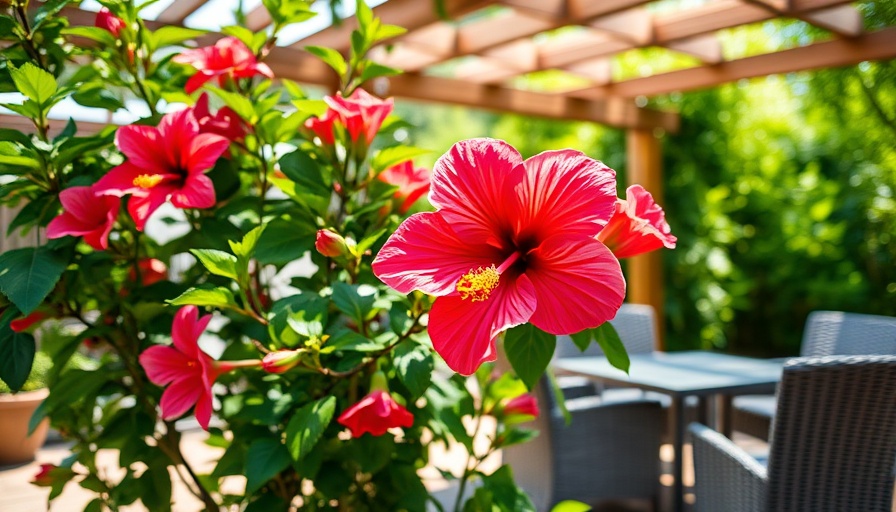
A Tropical Escape in Your Backyard: Transform Your Space with Shrubs
Picture stepping into your backyard and feeling as if you've been transported to a sun-soaked paradise. Tropical shrubs can revitalize any outdoor space, especially those sun-drenched corners or poolside patios. With various bold foliages and vibrant blooms, these plants deliver an instant vacation vibe, making them perfect for homeowners looking to enhance the ambiance of their outdoor environment. Here we explore 25 tropical shrubs that can turn your yard into a lush escape.
Transformative Power of Flowering Tropical Shrubs
Starting with flowering tropical shrubs, Hibiscus (Hibiscus rosa-sinensis) stands out with its striking large blooms that range from reds to yellows. This shrub's maintenance is straightforward—it thrives in warm, sunny areas and requires regular watering, providing vibrant colors throughout the season. Simply put, it's a pollinator magnet and an indulgent feast for the eyes.
Bougainvillea (Bougainvillea spp.) offers another powerful color alternative with its striking bracts that remain bright for months. This hardy plant can serve as a lush hedge or be trained to climb up structures, radically changing the garden's dynamic. With proper sun exposure, its triumphant blooms can take center stage in any garden landscape.
Besides aesthetics, flowering shrubs such as Plumeria (Plumeria spp.) provide olfactory pleasure. The sweet scent commonly associated with Hawaiian leis can elevate the outdoor experience, making evenings spent outside even more delightful, especially when paired with ambient lighting.
Focus on Foliage: Adding Color Beyond Blooms
While flowers brighten a garden, foliage can express personality and style in more subtle ways. Croton (Codiaeum variegatum) makes a statement with its vividly colored leaves, contributing to year-round interest in the garden design. Ideal in containers or as focal points, its multi-colored leaves catch attention wherever placed.
Another effective foliage option is Copperleaf (Acalypha wilkesiana), which brings deep color shades of bronze and burgundy that contrast beautifully against greener plants. This depth of color helps to create layers in your garden, enriching the overall visual appeal.
The Benefits of Incorporating Tropical Shrubs
Understanding the reasons behind these plant choices adds value to the decision-making process for homeowners looking to enhance their gardens. Tropical shrubs are not merely beautiful; they are usually drought-tolerant and resilient, which can result in lower maintenance needs over time. By selecting plants that thrive in the sun, homeowners can benefit from less watering and care while achieving a luxurious garden aesthetic.
Design Trends: Tropical Gardens in Modern Landscaping
In recent years, tropical gardens have gained immense popularity in modern landscaping. The trend stems from a wish to blur the lines between indoors and outdoors, creating a seamless flow designed to bring nature closer to living spaces. This inclination may also reflect society's growing desire for natural surroundings amidst increasingly urban environments.
Incorporating tropical plants can enhance privacy and provide a natural visual barrier as well. A mix of shrubs and taller plants can create secluded nooks, facilitating relaxation and leisure in private garden spaces.
Expert Insights and Practical Tips for Homeowners
When planning a tropical garden, consider the specific needs of each plant species. Before planting, soil quality and sun exposure should be assessed to ensure the optimal growth conditions are met. For instance, Plumeria thrives in well-drained soil whereas Ixora (Ixora coccinea) needs a bit more permanent moisture.
As sections of diverse plants come together, think about how colors can harmonize. Using complementary colors or varying leaf textures can lend a balanced look appealing to the eye. Grouping similar water and sun-require plants together also simplifies care, streamlining the gardening process.
Your Next Steps Towards a Lush Tropical Oasis
With these insights, it's time to take action and consider how you might include tropical shrubs in your landscaping. You have the tools and information at your disposal to create a personal tropical paradise right in your backyard.
Don't hesitate to visit your local nursery or garden center and ask for advice. It’s not just about picking the right plants; consulting with experts can help you discover newly available varieties or specific gardening tips for your local climate.
By investing in these tropical shrubs, you’re taking a step towards not only enhancing your home's aesthetic appeal but also creating a serene escape where memories can flourish for years to come. So go ahead, plant your dreams and watch them bloom.
 Add Row
Add Row  Add
Add 




 Add Row
Add Row  Add
Add 

Write A Comment